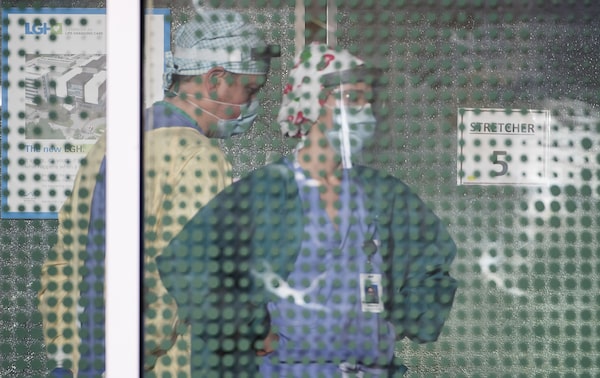
Health-care workers are pictured through the front window at the Lions Gate Hospital in North Vancouver on Apr. 13, 2020.JONATHAN HAYWARD/The Canadian Press
British Columbia will train more doctors and expand the ability of pharmacists to provide primary care as part of a relief package for the province’s overburdened health care system – a crisis that is resulting in delays in ambulance response, emergency room closures, a shortage of family doctors and growing wait lists for critical care such as cancer treatment.
Amid a global shortage of health care workers, B.C. Health Minister Adrian Dix announced on Thursday a five-year plan to recruit; retain; and train doctors, paramedics, nurses and other health practitioners.
B.C. will add new spaces for training doctors, with 40 new undergraduate medical education seats, and up to 88 new residency seats, starting in 2023 at the University of British Columbia’s Faculty of Medicine – a change that will take years to bear fruit. In the meantime, the province is broadening the scope of pharmacists and paramedics to deliver more primary services, in an effort to reduce wait times at walk-in clinics and primary health care centres.
Opinion: B.C.’s health care crisis keeps getting worse
As of Oct. 14, pharmacists be allowed to adapt and renew prescriptions for a wider range of drugs and conditions for patients who have lost their family doctor. Additional changes are in the works that would give pharmacists the ability to prescribe for minor ailments and contraception, starting next spring.
Paramedics and first responders will also be given more scope to better assist and treat people. For example, paramedics will be allowed to offer pain management while a patient is being transported to hospital. That change won’t improve ambulance wait times, Mr. Dix conceded, but he said his ministry is also working to train more paramedics. He noted that demand for ambulance services has increased dramatically since the start of the pandemic.
“We’re confident that the scope expansion will provide better health outcomes for patients who need emergency health services,” he said. “This is an element of redesign that is crucial to our health care system.”
B.C. Liberal health critic Shirley Bond said the plan is long overdue, and short on measurable targets. “This document is a collection of value statements and actions to be developed, not a plan with clear metrics and timelines ready to tackle the crisis that has already overwhelmed our system,” she said.
In B.C., nearly one million people do not have a family doctor. The lack of access to primary care has become dire as family doctors are retiring, reducing their hours or closing their practices entirely. In addition, many new graduates trained as family doctors are choosing more hospital-based work instead and specialized practice, which provide a predictable income, team supports, a vacation and maternity leave.
Last month, the Ministry of Health and Doctors of BC, which represents physicians in negotiations with the provincial government, announced one-time funding of $118-million that will support family doctors and medical clinics with their operational business costs. The funds will help tide physicians over while the province and the doctors hammer out a new compensation model.
Jennifer Lush, a spokesperson for BC Family Doctors for Patient Care, a grassroots advocacy group consisting of family physicians, said none of the recent changes will bring about the immediate help that’s needed now.
“Increasing enrolment or building new medical schools do nothing to fix a crisis we are in currently,” she said. “Plus, until we fix the system that we have, those medical students that graduate are not going to choose to go into family medicine. So we have to fix the dysfunctional system that we have currently in order to not only attract but also keep the family doctors that we currently have.”
The Globe and Mail has chronicled how British Columbia’s once-renowned cancer care system is buckling as staff shortages lead to soaring wait times. Insiders at B.C.’s cancer care agency have sounded the alarm about shortages of medical staff, support staff, and machines used to detect and treat cancer.
B.C. in particular is falling behind. Data show that, in September, only 20 per cent of B.C. patients referred to an oncologist were seen within two weeks, compared with Ontario where about 75 per cent of patients are seen within two weeks. As well, B.C. is now the poorest performing province in meeting national benchmarks for access to radiation therapy for cancer patients.
Mr. Dix noted that his government has added 38,000 health care workers to the payroll since 2017, but said it is not enough. The pressure on the province’s health care system is growing because of an aging population, the pandemic and the public-health crisis owing to toxic drug supply. The compounded stresses are leading to high levels of burnout in the health care sector, prompting high staff turnover and retirements.
The Health Minister noted that there is a growing global shortage of health care workers, which means the province is facing tough competition from around the globe to attract and retain those workers. The province is working with the health colleges and the federal government to reduce the barriers faced by health care workers who want to come to B.C. to practice.
Aman Grewal, president of the BC Nurses Union, welcomed the plan but said it lacks concrete measures to address the province’s nursing shortages. “We would like to see more short-term solutions that focus on the nursing shortage,” she said in an interview Thursday.
The organization representing pharmacists welcomed the changes and said his members are already trained to take on a larger role in prescribing medications.
“We’re trained to do much more than what we’ve been able to do for a long time,” said Jamie Wigston, presidents of BC Pharmacy Association. He said the shortage of family doctors is leaving patients anxious about running out of needed medications. “I often hear from patients who are trying to access primary care to renew prescriptions. … This is especially important for individuals dealing with mental health and substance use disorders, who need access to their medication in a timely and critical manner.”
Mr. Dix said the plan takes aim at the existing staffing crisis, but also a looming one. While the province’s population is growing and aging, many health care workers are nearing retirement age as well: There are 400 family doctors in B.C. who are over the age of 70. Others also reducing their workload in the face of the sustained pressure of the past three years.
That means B.C. needs to improve working conditions in the health care system: to allow workers more flexibility to work around child-care needs, for example, and to tackle violence in the workplace.
B.C. is also working with the health colleges and the federal government to make it easier for doctors and other health care workers from other jurisdictions to bring their skills to B.C. There are thousands of doctors in the province who cannot practise now, because the process of getting accreditation here takes up to two years to complete.
 Justine Hunter
Justine Hunter Xiao Xu
Xiao Xu